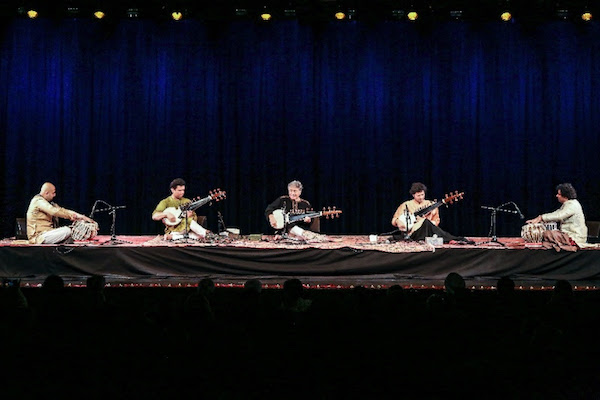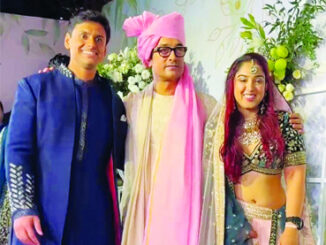
By Mabel Pais
“Music has connected the world and is the common expression of every human being” – Maestro Amjad Ali Khan
“…the finest living exponent of the sarod” – The Guardian
Sarod Maestro Amjad Ali Khan’s concert ‘Musical Celebration of Lights and Life’was presented by the Indo-American Arts Council (IAAC) on November 3, at Symphony Space, Manhattan, New York City.
The theme of the concert was “Diwali, The Festival Of Lights”.
The event was enthusiastically attended by about 600 leading members of the Indian diaspora from the fields of the arts and culture, entertainment, sports, finance, and medicine, among other fans.
The evening began with an address by IAAC board member Anurag Harsh, who thanked the patrons and IAAC members for supporting Indian arts. Chairman Dr. Nirmal Mattoo spoke of his long association with Amjadji.
This was followed by the lamp lighting ceremony to kick off the Diwali concert. Besides, the stage was lit with diyas and flowers giving a very festive appearance.
“The most charismatic performer of Indian Ragas…”
-The New York Times
THE CONCERT
The concert was in 3 sections.
The first section or the appetizer to the “main course” as his younger son Ayaan put it, was performed byhis sons, Amaan Ali Bangash (older) and Ayaan Ali Bangash (younger). They played Raag Jhinjhoti in 2 compositions with 91/2 beats and 16 beats.
The second set or the “main course” brought Khan Saheb, as he is popularly called, to the stage. Accompanying the Maestro on the stage were Anubrata Chatterjee, son and disciple of Pandit Anindo Chatterjee and Amit Kavthekar, disciple of Alla Rakha Khan Saheb and Ustad Zakir Hussain.
Commending IAAC for their service, he also spoke about his association with New York City, coming here as a young boy in 1963. “Music has connected the world and is the common expression of every human being” he said. It being Diwali, he decided on melodies played at the time of roshni, melodies that have the happiness of light and also sadness of entering a different world. He started with Raag Shyama Gauri with 14 beats time cycle.
The next piece played was Raag Saraswati, which is a rare raga, having no record of this raga on sarod and hence is difficult, technically. Another composition was Raag Durga. Both are named after goddesses and are so different musically, but they come with a beautiful message.
In addition, celebrations continued for #GandhiAt150 with the maestro playing a few songs popularized by Mahatma Gandhi.

Khan Saheb noted that most of the songs are based on language whether folk music, Dhrupad, Dhamar, Thumri etc. In the 13th century sufi saint Hazrat Amir Khusrau created the qawwali with many new instruments, new raagas. He created a new style of singing called tarana that doesn’t deal with language, so he created a language of music, of syllables. Khan Saheb having composed many taranas, sang one at the concert in Raag Bahar. His next piece was Raag Malkauns composition in Jhaptal 10 beats time cycle with a taarana of different kind.
In conclusion of his solo, he played the devotional songs which were also favorites of Mahatma Gandhi, Vaishnava Jana To and Ram Dhun.
In the third set, joining him on stage were his older son Amaan Ali Bangash and younger son Ayaan Ali Bangash. They played Raag Desh, a composition in a beautiful melody and the Bengali song by Tagore Ekla Chalo Re.
Amjad ji spoke to the audience, explaining the necessity to file his nails on stage, as there are grooves in his nails, after each item. Sarod cannot be played with fingertips and the musician needs to press with the edge of the fingernails to bring out the resonance, to bring out the human emotions.
Khan Saheb also spoke of Tagore, who was a great poet and also a great composer. The maestro had the honor of playing with the great singer Suchitra Mitraand had made an album of 10 songs of Tagore. Most of Tagore’s songs were based on Indian classical Ragas but Tagore took liberty with them. Only a genius can do that and only another genius such as Amjad Ali Khan Saheb can play as melodiously as he did this evening.
Ending the event, host Anurag Harsh, whom the maestro had praised earlier in the evening, wished the audience a very happy Diwali. The event was followed by a dinner and VIP reception.

Photos / Courtesy IAAC.
ABOUT MAESTRO AMJAD ALI KHAN
He is India’s most celebrated classical musician and an undisputed master of the Sarod, a stringed instrument used in classical Indian music. He is the seventh generation of musicians playing the same instrument, being heir to a long and distinguished musical lineage. He gave his first performance at age six and has since performed his own compositions with the finest orchestras and ensembles in venues around the world, including an acclaimed performance at the 2014 Nobel Peace Prize Concert in Norway. The Grammy-nominated musician has won many prestigious awards including the Crystal Award at the World Economic Forum, UNICEF’s National Ambassadorship, and India’s prestigious awards, the Padma Vibhushan and the Sangeet Natak Academi award for music.
Based on his belief that music transcends all, he has broadened the appeal of Indian music and its spirit throughout the world, transcending race, region and generation. In the current political climate, there is even more reason to find commonality and feel inclusive. Human emotions are universal and are the common thread binding us as a community. Khan affirms “Since my childhood, I always wanted my instrument, the Sarod to be able to express the entire range of human emotions…to Sing, Shout, Whisper and cry. All the emotions! It has been a long journey so far and by the benevolence of the heavens, the Sarod has become far more expressive than it was 35 years ago.”
Khan has had a long association with New York. In his own words, “ New York holds a very special place in my heart and my association with this city goes back nearly fifty-five years. Today, I feel so happy to see the awareness and love that Indian music has generated over the period of time, especially in this part of the world.”
To learn more about Maestro Amjad Ali Khan and his sons, visit ww.sarod.com.
ABOUT INDO-AMERICAN ARTS COUNCIL:
The IAAC supports all the artistic disciplines in classical, fusion, folk and innovative forms influenced by the arts of India. The Council works cooperatively with colleagues around the United States to broaden its collective audiences and to create a network for shared information, resources and funding. The focus is to help artists and art organizations in North America as well as to facilitate artists from India to exhibit, perform and produce their work here. For more information or to become a member, visit www.iaac.us.
© Indo-American Arts Council Inc.
303 Fifth Avenue, Suite 1007, New York, NY 10016. Email: admin@iaac.us Web: www.iaac.us
Follow IAAC on social media at
Facebook @IAAC.us,Twitter @IAArtsCouncil andInstagram @IAArtsCouncil
(Mabel Pais writes on The Arts and Entertainment, Social Issues, Spirituality, and Health and Wellness)





Be the first to comment